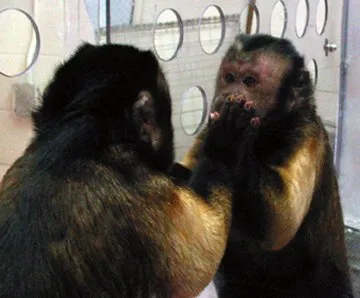Reflections of Primate Minds: Mirror images strike monkeys as special
When a capuchin monkey looks at its own image in a mirror, something strange happens. The diminutive creature reacts not as if it sees a stranger, as many researchers had assumed. Instead, the reflection gets treated as a special phenomenon, generally eliciting curiosity and friendly overtures from females and a mix of distress and fear from males, a new study finds.

Capuchins’ reactions signal an intermediate self-awareness that lies somewhere between seeing the mirror image as another individual and recognizing the reflected figure as self, according to a team led by psychologist Frans B.M. de Waal of Emory University in Atlanta.
“It’s clear that capuchins don’t regard their mirror image as that of a stranger,” de Waal says. “I’m not sure why they react as they do to mirrors.” He suspects that confused capuchins are responding with sex-specific tactics for dealing with ambiguous situations.
Investigators typically regard an animal as self-aware if it inspects a paint spot on its face in a mirror. People routinely pass this test by about age 2. Apes and dolphins often do so as adults. Capuchins and other monkeys ignore facial markings in the mirror.
Yet capuchins distinguish the sight of their own reflections from the sight of other individuals, much as human babies do at about age 1, de Waal says.
He and his colleagues studied eight female and six male monkeys housed at a research facility in Georgia.
Each capuchin was placed in a test chamber and exposed twice to each of three conditions: seeing an unfamiliar, same-sex monkey on the other side of a clear barrier positioned behind a mesh screen; seeing a familiar, same-sex monkey through the same setup; and seeing his or her own reflection in a mirror placed behind a mesh screen. Each condition lasted for 15 minutes.
When faced with a stranger, females avoided eye contact and otherwise appeared anxious. Males made threatening gestures. Familiar monkeys elicited few reactions.
Monkeys reacted to their mirror images in much different ways, de Waal’s group reports in the Aug. 9 Proceedings of the National Academy of Sciences. Females typically gazed into their own reflected eyes while making friendly gestures, such as swaying or lip smacking. “They almost flirt with their reflection,” de Waal says.
Males likewise made more eye contact with their mirror images than with strangers or friends. But they also reacted with signs of confusion and distress, such as squealing, curling up on the floor, and trying to escape from the test chamber.
Such responses may occur when a male capuchin faces another male whose unceasing mimicry makes him impossible to dominate, de Waal speculates.
The new study convincingly shows that capuchins get “weirded out” by seeing themselves in mirrors and don’t treat such images as they do strangers, remarks anthropologist Dean Falk of Florida State University in Tallahassee.
However, capuchins of each sex may simply be displaying automatic social reactions to unusual monkeys that mimic them, comments psychologist Gordon G. Gallup Jr. of the State University of New York at Albany. “It doesn’t necessarily follow that they have achieved an intermediate level of self-awareness,” he says.